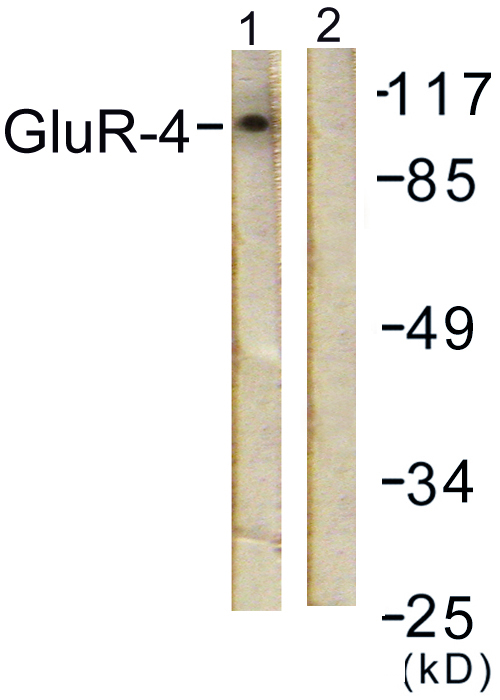GluR4 Polyclonal Antibody
- Catalog No.:YT1924
- Applications:WB;IHC;IF;ELISA
- Reactivity:Human;Mouse;Rat
- Target:
- GluR4
- Fields:
- >>cAMP signaling pathway;>>Neuroactive ligand-receptor interaction;>>Circadian entrainment;>>Retrograde endocannabinoid signaling;>>Glutamatergic synapse;>>Dopaminergic synapse;>>Huntington disease;>>Pathways of neurodegeneration - multiple diseases;>>Amphetamine addiction;>>Nicotine addiction
- Gene Name:
- GRIA4
- Protein Name:
- Glutamate receptor 4
- Human Gene Id:
- 2893
- Human Swiss Prot No:
- P48058
- Mouse Gene Id:
- 14802
- Mouse Swiss Prot No:
- Q9Z2W8
- Rat Gene Id:
- 29629
- Rat Swiss Prot No:
- P19493
- Immunogen:
- The antiserum was produced against synthesized peptide derived from human GluR4. AA range:828-877
- Specificity:
- GluR4 Polyclonal Antibody detects endogenous levels of GluR4 protein.
- Formulation:
- Liquid in PBS containing 50% glycerol, 0.5% BSA and 0.02% sodium azide.
- Source:
- Polyclonal, Rabbit,IgG
- Dilution:
- WB 1:500 - 1:2000. IHC 1:100 - 1:300. ELISA: 1:20000.. IF 1:50-200
- Purification:
- The antibody was affinity-purified from rabbit antiserum by affinity-chromatography using epitope-specific immunogen.
- Concentration:
- 1 mg/ml
- Storage Stability:
- -15°C to -25°C/1 year(Do not lower than -25°C)
- Other Name:
- GRIA4;GLUR4;Glutamate receptor 4;GluR-4;GluR4;AMPA-selective glutamate receptor 4;GluR-D;Glutamate receptor ionotropic; AMPA 4;GluA4
- Observed Band(KD):
- 100kD
- Background:
- Glutamate receptors are the predominant excitatory neurotransmitter receptors in the mammalian brain and are activated in a variety of normal neurophysiologic processes. These receptors are heteromeric protein complexes composed of multiple subunits, arranged to form ligand-gated ion channels. The classification of glutamate receptors is based on their activation by different pharmacologic agonists. The subunit encoded by this gene belongs to a family of AMPA (alpha-amino-3-hydroxy-5-methyl-4-isoxazole propionate)-sensitive glutamate receptors, and is subject to RNA editing (AGA->GGA; R->G). Alternative splicing of this gene results in transcript variants encoding different isoforms, which may vary in their signal transduction properties. Some haplotypes of this gene show a positive association with schizophrenia. [provided by RefSeq, Jul 2008],
- Function:
- function:Ionotropic glutamate receptor. L-glutamate acts as an excitatory neurotransmitter at many synapses in the central nervous system. Binding of the excitatory neurotransmitter L-glutamate induces a conformation change, leading to the opening of the cation channel, and thereby converts the chemical signal to an electrical impulse. The receptor then desensitizes rapidly and enters a transient inactive state, characterized by the presence of bound agonist.,miscellaneous:The postsynaptic actions of Glu are mediated by a variety of receptors that are named according to their selective agonists. This receptor binds AMPA (quisqualate) > glutamate > kainate.,PTM:Palmitoylated. Depalmitoylated upon glutamate stimulation. Cys-611 palmitoylation leads to Golgi retention and decreased cell surface expression. In contrast, Cys-837 palmitoylation does not affect cell surface expression but regul
- Subcellular Location:
- Cell membrane; Multi-pass membrane protein. Cell junction, synapse, postsynaptic cell membrane; Multi-pass membrane protein. Cell projection, dendrite. Interaction with CNIH2, CNIH3 and PRKCG promotes cell surface expression. .
- Expression:
- Brain,Donated clones,PCR rescued clones,
- June 19-2018
- WESTERN IMMUNOBLOTTING PROTOCOL
- June 19-2018
- IMMUNOHISTOCHEMISTRY-PARAFFIN PROTOCOL
- June 19-2018
- IMMUNOFLUORESCENCE PROTOCOL
- September 08-2020
- FLOW-CYTOMEYRT-PROTOCOL
- May 20-2022
- Cell-Based ELISA│解您多样本WB检测之困扰
- July 13-2018
- CELL-BASED-ELISA-PROTOCOL-FOR-ACETYL-PROTEIN
- July 13-2018
- CELL-BASED-ELISA-PROTOCOL-FOR-PHOSPHO-PROTEIN
- July 13-2018
- Antibody-FAQs
- Products Images

- Western Blot analysis of NIH-3T3 cells using GluR4 Polyclonal Antibody

- Western blot analysis of lysates from NIH/3T3 cells, treated with Forskolin 40nM 30', using GluR4 Antibody. The lane on the right is blocked with the synthesized peptide.



